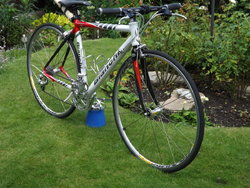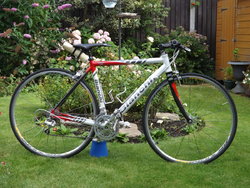TheCyclingRooster
Veteran
- Location
- Scarisbrick,Lancashire
Hi to all of you.
I have just purchased a new Campagnolo Veloce Double front derailleur for use on my newly acquired 50cm Bianchi Via Nirone 7 Alu Carbon frame.
I intend to use it as a triple with my Campagnolo Veloce Flat bar Shifters - bought some 4 years ago but never commissioned.
Now I have always understood that the sprockets are on the cassette and that reference to 'High Gear' means the smallest sprocket on that cassette.
They refer to the chain being on the smallest gear - why don't the call it what it is - the smallest chairing ?
They talk about the derailleur 'fork' - what fork ? Again,why not what it has been known by/as since they were first developed - the front derailleur cage or chain guide rails.
Yes they do change terminology later in the fitting and adjustment booklet and then refer to it as the derailleur cage.
I find it strange that they are reliant upon the owner/user being able to understand their changes of reference rather than make it simple for even the newest to DIY cycle maintenance being able to cope with fitting their components.

I have just purchased a new Campagnolo Veloce Double front derailleur for use on my newly acquired 50cm Bianchi Via Nirone 7 Alu Carbon frame.
I intend to use it as a triple with my Campagnolo Veloce Flat bar Shifters - bought some 4 years ago but never commissioned.
Now I have always understood that the sprockets are on the cassette and that reference to 'High Gear' means the smallest sprocket on that cassette.
They refer to the chain being on the smallest gear - why don't the call it what it is - the smallest chairing ?
They talk about the derailleur 'fork' - what fork ? Again,why not what it has been known by/as since they were first developed - the front derailleur cage or chain guide rails.
Yes they do change terminology later in the fitting and adjustment booklet and then refer to it as the derailleur cage.
I find it strange that they are reliant upon the owner/user being able to understand their changes of reference rather than make it simple for even the newest to DIY cycle maintenance being able to cope with fitting their components.




